

Featured Article of the Month
Unmasking Traditional Japanese Theatre in Singapore - Interview With Dr Lim Beng Choo
| In this edition of Kizuna Story, JCC speaks to Dr Lim Beng Choo, Associate Professor at the Department of Japanese Studies, Faculty of Arts & Social Sciences, National University of Singapore (NUS). Learn more about her journey with Japan and Japanese culture, especially in the field of traditional Japanese theatre. |
|
How did you become interested in Japanese culture, Japanese language, and Japan?
My interest in Japan only developed after I became a Japanese Studies major student at NUS. Before that Japan was just another exotic foreign land depicted in literary works and the media. Why did you choose to study Japanese Studies at NUS? My encounter with Japanese Studies was really incidental. On my first day on campus, I found the Japanese Studies Department and thought it would be interesting to study a country that I only knew from the media and literature. At the end of my first year I was awarded a two-week fieldwork fellowship to Japan which changed the course of my life. The people and things that I have encountered were interesting and inspiring - my most vivid memory was the visit to the Kabuki Theatre followed by the very first bowl of ramen in a small ramen shop nearby. The sight and sound of the theatre, the smell and taste of the restaurant and its food, and the rhythm of the city became the original landscape on which I started my Japan journey. I have never looked back. I eventually did my doctorate degree on noh, the colourful and enticing traditional Japanese theatre which is still very much my favorite theatrical genre. One of my favorite places to visit in Japan is definitely the Nōgakudō (noh theatre), as well as all the Kokuritsu Gekijō (National Theatre of Japan). | 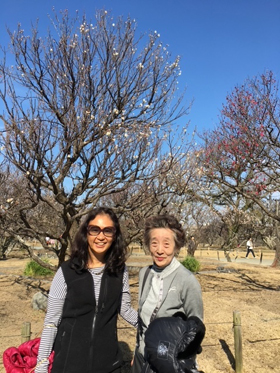 Early spring in a park in Fukuoka 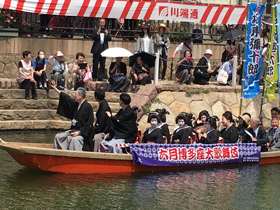 Kabuki Kaomise, Kyushu 2018 |
|
How many years have you been teaching at NUS Department of Japanese Studies and doing research relating to Japan?
Before going away to do my PhD at the Department of Asian Studies at Cornell University, I taught for about a year in NUS. After I returned in the late 1990s, I have taught various subjects both on premodern and modern Japan. Although my research work focused mainly on traditional Japanese theatre, I have also dabbled in the fields of film, translation and nowadays, digital humanities. What sparked your interest to do research and work related to Japan and its traditional culture and performing arts, especially in the area of noh theatre? Ever since I was little, theatre has always been one of the most mesmerising experiences to me. In noh, my interest was intrigued when I first heard the flute (nohkan). In my mind, the nohkan’s somewhat piercing yet resonating sound embodies perfectly the two key characteristics of noh: its minimised and stylised performance style as well as its rich literary tradition. The more I study about noh and other premodern theatrical art forms, the more I realized that they are not just theatrical forms, but an excellent lens through which one could learn about the culture and history of Japan. To think about traditional theatre in an advanced country like Japan seems irrelevant, but it is exactly the constantly changing social and cultural context in which the traditional theatre situated that makes it most relevant. I hope my work illustrates this important aspect of traditional theatre. What are some of the key Japanese-related projects you have been doing or are involved in? |
|
Since 2017, I have invited renowned kyogen performer Shigeyama Sennojō to come to NUS to give guest lectures and workshops, and a public kyogen performance in 2019. We have continued having Mr Shigeyama as our guest lecturer online because of COVID-19. I have also coordinated the recording of kyogen and noh performance.
I also have organised international conferences and regional symposiums and invited Japan scholars from ASEAN countries, Japan and North America to share their expertise on subject matter related to traditional Japanese performance. Two of my recent research projects focus on presenting data through visualisation tools to tell stories of Japanese performances in Singapore. The first project “Japanese Performances in Singapore – Cultural Interactions and Beyond” will be launched in April 2022. This is a record of visiting Japanese performances to Singapore since the late 1800s till 2020. The second project, still a work in progress, focuses on the use of technology in traditional theatre. A paper related to this aspect of the traditional theatre was presented in a conference and will be published this year. |
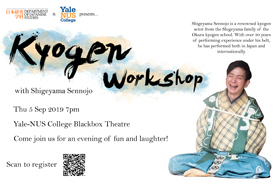 Kyogen workshop poster 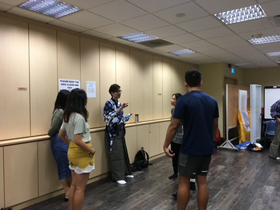 Workshop with Mr Shigeyama Sennojo at NUS |
|
How has Singaporeans’ (be it NUS students or public) perspective and interest towards Japan, Japanese culture, and traditional arts changed throughout the years? How have you helped to increase interest in Japan?
I think that over the years, interest in Japan amongst Singaporeans, especially the younger generations like students in NUS and other institutions, have remained strong. It is not just the appealing aesthetics and often relatable contents of Japanese manga and anime—other aspects like Japanese fashion, food, art, and films have their staunch followers as well. On my part, I am always keen to promote traditional Japanese theatre by inviting performers, organising shows, and incorporate traditional Japanese theatre and culture in my syllabus. How was your experience in Japan when you were visiting research fellow at Ritsumeikan University? During my sabbatical year at Ritsumeikan University in Kyoto, I was able to experience first-hand the many festivities and performances in and around Kyoto city, other than participating in academic work. My daughter went to the local Japanese kindergarten which allowed me to learn more about the excellent Japanese pre-school education. It was a very enriching and fulfilling year. Has Japanese culture influenced or changed you, and have you incorporated any aspects of Japanese culture in your daily life? I think learning about Japan and Japanese culture has definitely expanded my world view and helped me navigate better when I do research. Outside of work, Japanese food has a prominent position in my kitchen. Both my husband and daughter like many things about Japan – the food, the culture, the places of interests, and so on. Recently my daughter has “discovered” anime and has started to plead with me to teach her Japanese, which I have gladly obliged. We are always looking forward to visiting Japan, to meet our friends and enjoy the unique things about Japan such as onsen (hot springs) and matsuri (festivals), and most importantly, to visit the theatres! |
|
What are your hopes for the Singaporean students who choose to study Japanese Studies at NUS?
I would like to see my students use the skill and knowledge that they have acquired about Japan to contribute to a better understanding between Singapore and Japan and to build even stronger ties between the two countries. Even if they do not start a career in a Japan-related industry, I hope that learning about Japan in depth has helped them to appreciate cultures other than our own. Do you have any future plans to conduct more research in, or to visit Japan? I would like to return to Japan soon, to watch shows and spend a substantial amount of time to work in the archives. And of course, when I am doing research in Japan, I will also want to find time to meet my friends and do the fun things that we have so missed in the past two years. What are your hopes for the future of Japan and Singapore’s relationship? |
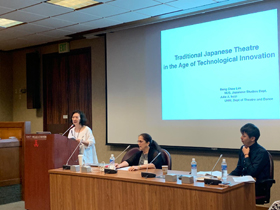 Paper presentaton at a conference in University of Hawaii at Manoa 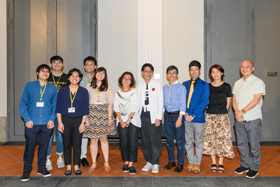 With crew members and performers after kyogen performance at Yale NUS Play Den in September 2019 |
| I am grateful that I have had the opportunity to study in-depth about Japan–an enriching, inspiring, and fun journey that I hope my students will also get to embark on. I hope that the relationship between Japan and Singapore will continue to develop further and stronger, and that more people from both places will develop more interests in different aspects of our countries and explore more exchange opportunities. That is probably the best way to strengthen our relationships. |
* All photos used in this article are provided by the author unless otherwise stated / © Dr Lim Beng Choo
|
Japan Creative Centre 4 Nassim Road, Singapore 258372 +65 6737 0434 / jcc@sn.mofa.go.jp https://www.sg.emb-japan.go.jp/JCC/ Nearest parking at Orchard Hotel & Delphi Orchard |
 |